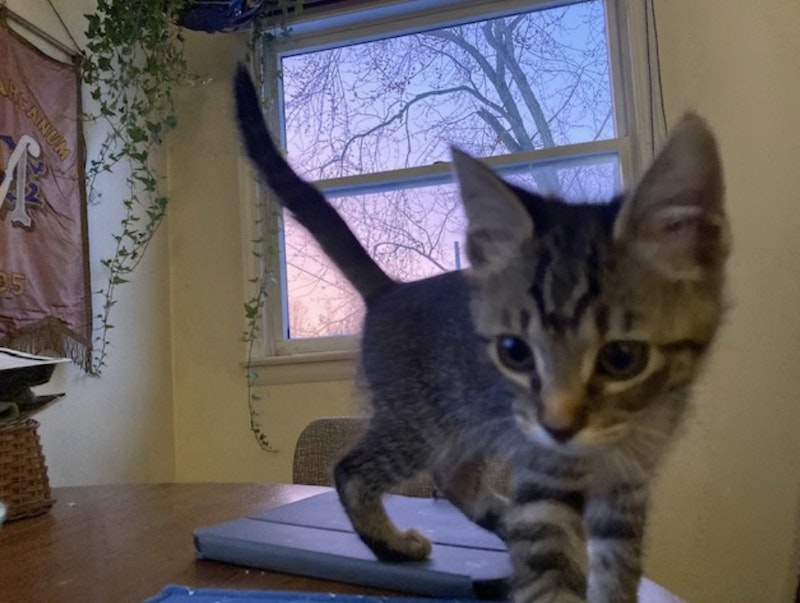When you bring home that new kitten (call “her” “Sylvie,” but she hasn't yet specified her pronouns), the first thing she's going do is mew, then shiver, and then try to hide. With those phases discharged, likely in a matter of seconds, she’s going to start mapping the room as completely as possible, then memorizing the map, and then expanding it, as though she were Amerigo Vespucci arriving in a new hemisphere. A cat is a world explorer, and the maturation of a cat entails the expansion and refinement of her catmap. The basic sensory capacities and intelligence of the feline are visual and spatial, which no doubt emerges from the stalking lifestyle.
When we brought Sylvie the gray tabby home last month, she was six or seven weeks old. When we opened the door of the carrier, she retreated to the back and gazed at us from that tiny face with big eyes, ears pricked all the way up. A minute later she was circumnavigating the living room, starting along the edges and working in concentric circles toward the center. She stopped to touch each object with a paw or with her nose, or maybe give it a little taste, and was on to the next. Then perhaps she returned to the first one and touched it again, as though being sure it was still there, a permanent feature, and establishing its spatial relation to the second thing. She probably took 15 minutes on the task before realizing that it was time to eat and sleep.
Over the next few hours, she circumnavigated and charted each room, closet, cupboard she entered, at first hesitantly, but moving quickly into explorer mode. And as she's gotten more physically capable, ever-more cat-like in her agility, over the past few weeks, the representation has expanded into three dimensions, like the clockwork map from Game of Thrones. She's started getting up on the backs of chairs, up onto tables, bookcases, windowsills, counters, adding a series of vertical layers to the horizontal chart. She must be frustrated at this point that she can't walk around on the ceiling.
Generating a representation of the space around them and the objects in that space seems essential to a cat-style predator, especially one who’s also liable, on a bad day, to end up as prey. Out here in rural central Pennsylvania, there are colonies of feral cats, no doubt mapping the whole region, and there are animals that take cats, such as foxes and coyotes. But in those sorts of conditions, it’s a matter of life and death to know where to find the nearest good cover, to know which features are permanent and which mobile or ephemeral, to be able to detect any change as well as any movement.
I've noticed this for years with my 12-year-old gray tabby Thistle. Bring a box in, as one now does so often, and even if she didn't see it come in, it's the first thing she notices. She'll still circumnavigate it and touch it, though maybe she no longer tries to leap into or onto it. Once she has it fixed in her mind, she dismisses it. But she's always aware of every new thing in every room, always interested, still continually reconstruing her environment as it shifts.
Yesterday we were putting together a large cabinet in the living room. Sylvie was registering every change, jumping around the boxes, tearing or bopping at the packing materials. But Thistle was looking in through the window, refusing to enter an environment so familiar and yet at that moment so reconfigured and volatile. It's dangerous in there, her rebuking look through the glass seemed to say. Call me when you're finished.
Different species, it strikes me, have different relations to the world we all inhabit together, or perhaps different techniques and capacities for representing it. Dogs probably identify recurring objects and people by smell, for example. Their representation of the space they're in is a smell chart oriented around what the things and creatures around them are exuding or emitting. That probably yields a lot of information very quickly about what sort of things they are, which takes a cat a while longer to establish to her satisfaction. I think our maps are nearer to the cats': we’re primarily visual and tactile too. But we map very differently, because we move very differently: we rarely see the world from the mantelpiece, the top of the fridge, or the back of the cupboard. The cats have a more complete map.
But, though we represent the world so differently, it’s the same world that we all represent, even with our different sensory and kinesthetic abilities and experiences. The cat does it by sight and the dog by smell, but they both recognize familiar people and objects, which are familiar to us as well. When it's time to leave, we'll all push at the door rather than trying to pass through a wall. This is because there’s exactly one world which we're trying to negotiate with our different capacities, one world that we share, even as we experience it in ways that are distinctive to a species and even to some extent in ways distinctive to an individual.
I imagine the mapping capacity is inborn and instinctual in cats. But what they map isn’t instinctual; how the instincts are applied can’t itself be an instinct. Every environment is different, and none is preloaded into a cat's brain (if it were, the cat could not survive in the actual world). A creature could have an instinct to explore, but no instinct specifies what it finds when it does. It has to be open to new information, and I feel that it has to be doing something analogous to what, when we do it, we call reasoning.
If you're raising a kitten (which I recommend), this is a difficult conclusion to avoid.

